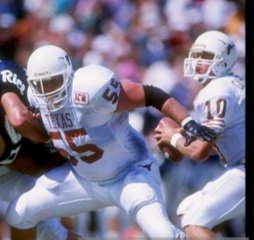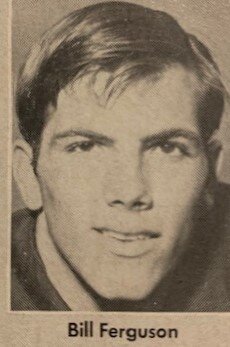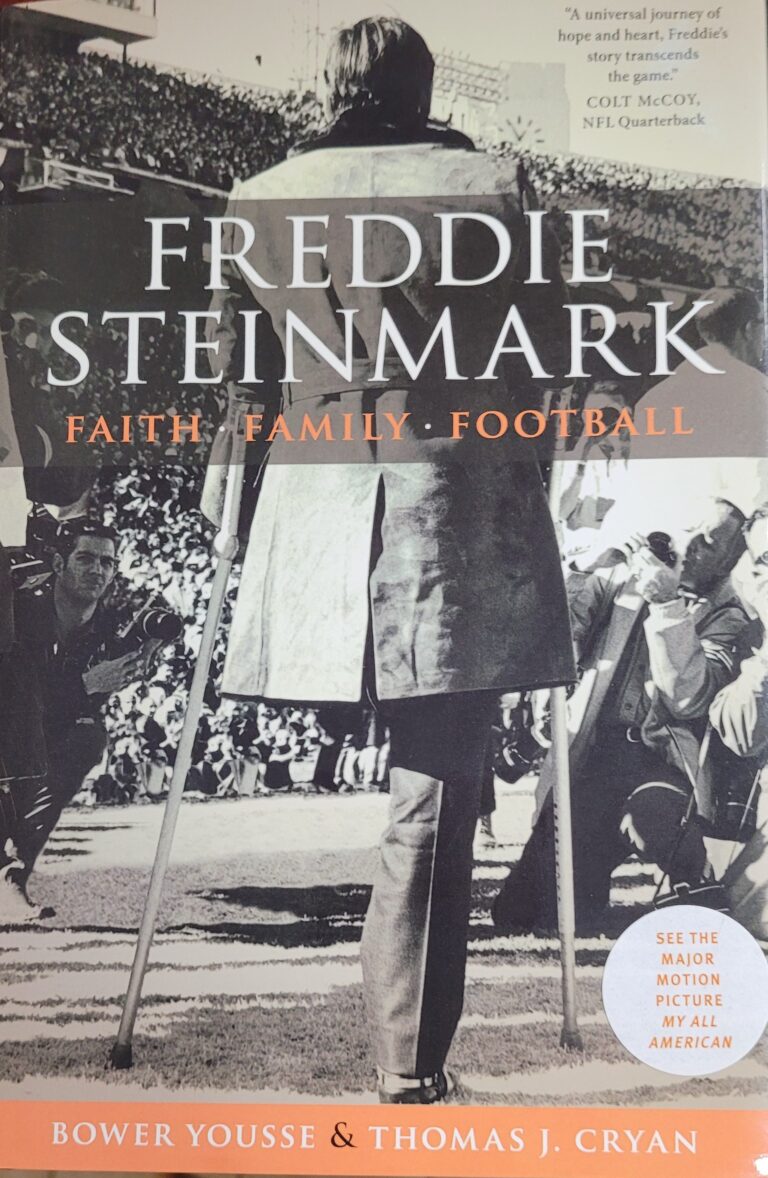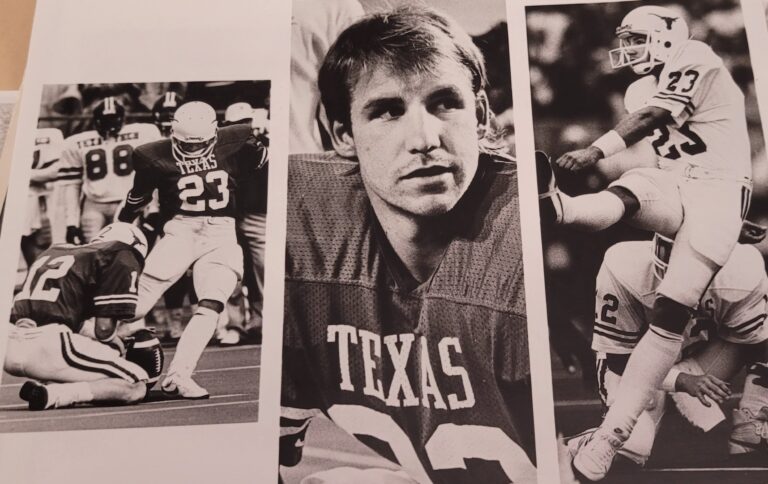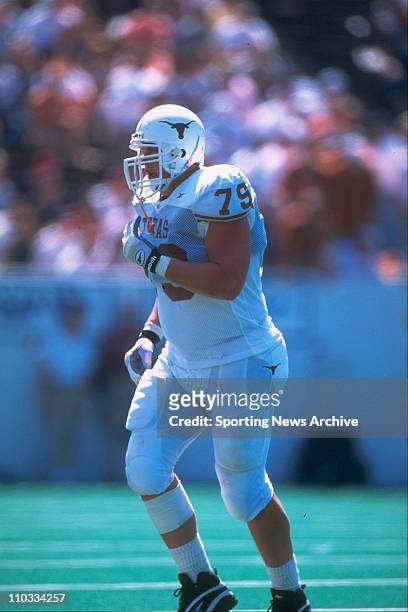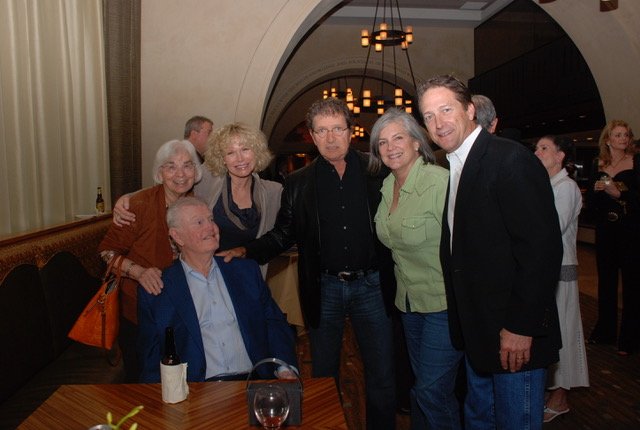Interview of Pat Culpepper by his son John
Dad’s Interview with Longhorn Legacy Network
The Professor and Pat Culpepper in New Orleans
Q. You played linebacker and fullback at Texas in the last part of the era in which players were trained to “go both ways.” Looking back, what do you see as the key to how you and your teammates (and opponents) were so well-conditioned and prepared to play on both sides of the ball? Unlike today’s players, y’all weren’t working out 365 days a year and getting weight training.
A. I think the trainer, Frank Medina, making us run up stadium stairs at Memorial Stadium; we had to run stairs and run the entire stadium. We were one of the first teams to work with weights, which Coach Royal implemented. My high school coach, Brooks Conover, bought weights for the high school, which was unique at the time; not many were working out with weights, which kept us from getting hurt. I also was in the Marine Corps reserves in the summers, and going through basic training in Virginia gave me a competitive edge.
Q. Name a couple of the toughest guys you played alongside in your three varsity seasons at Texas?
A. Johnny Treadwell tremendous hitter on defense and a great offensive guard. He had tremendous acceleration when he tackled, he went through the tackles and knocked them back. Scott Appleton, defensive tackle, 6’ 3”, had a great low stance, which allowed for him to get under the offensive line, and his arms were long, allowing him to separate from the blocker.
Q. And you had a reputation as a fiery player, was any other Longhorn meaner than you?
A. (he laughed) “Johnny Treadwell, he was always talking to me during the game, we fed off each other. He was enthusiastic and a great football player. In the heat of the battle, we were like 2 warriors.”
Q. Where did that fiery temper come from? What was the thing that motivated you the most to get everything out of you as a player?
A. From my mother, Willie Dell Culpepper, she was 5’ 3”, she was a drill sergeant. She was a educator for her entire life and she made me toe the line. She loved football. For my father, John Culpepper, he was even keel, smart, and was the calming influence on our family.
Q. What was the thing that motivated you the most to get everything out of you as a player?
A. It started back in high school. Coach Conover, pushed us to be the best, athletically and academically. He demanded and coached everything we did at 100 %, and he used film to evaluate our practices and coached us on what the film showed. He built trust and respect that his players wanted to be our best for ourselves but for the university of Texas. That carried over to college with Coach Royal, Coach Pitman, and Coach Cunningham. I had a love and passion for the game that my thinking, “I will not lose.”
Q. Your book, “Goal Line” focuses on your senior season of ’62, climaxing with the midseason matchup against Arkansas in Austin. That famous, game-saving tackle you made with Johnny Treadwell has stood up for 60 years as one of the biggest stops in Longhorn history. What sticks with you about that game, its high stakes, and atmosphere, after all these years?
A. It was the two teams that were best in SWC; they had a great coach, Frank Broyles, and great players, Jerry Jones and Jimmy Johnson, to name 2. They made us ready for every aspect of the game, Kicking Game, Offense and Defense.
-
We had to come from behind to win; it was a great defensive game. Everyone on our football team, at halftime, understood the game was going to come down to the 4th quarter, and it was going to be 60 minutes of hell. As a defense, we knew we had to create a turnover.
-
It was the largest crowd at the time at Memorial Stadium; people cut open the fences to sneak in, and every square inch of the field had people everywhere. The crowd lined the streets and the parking lot when our bus pulled up.
-
On the goal line play, when we broke the huddle, John Treadwell looked at each one of us and pointed his finger, and said, “We’ve got ‘em where we want ‘em.”
-
The play before the famous play was a completed pass to get Arkansas to the 4 and then on first down, they got 3 yards, and on Second down and 1, from the 1-yd line, our defensive line did such a great job of getting under the blockers, it gave Treadwell and me a clear shot at Danny Braham. I was put in the right position and right place by my coaches and teammates.
Question “Do you remember the crowds reaction?
The fumble rolled over my shoulder, Ken recovered, and I could not hear anything, the crowd went nuts.”
We got the ball back and every time we made a first down, on offense, the cannon was shot, the drive took forever and the stadium was going crazy, you could not hear. We had to score to win.”
Q. Today’s high school and college games frequently produce more scoring than basketball…the winner is just the last team with the ball. If you were coaching again in today’s high tempo and “Air Raid” schemes, what would you emphasize to improve defensive play?
A. “You start with the secondary, you have to play four deep, when I was coaching, it was more 3 deep. You need the secondary to be able to run with the receivers. 1 to 2 linebackers, and they must be able to run and cover as well. Each week, even though they are all throwing the ball around, each week you really must change what you are doing. You must be able to confuse the quarterback and receivers, even in high school, showing one look and coming back with a different look when the ball is snapped. Offensively, if you can run and run it well, it helps keep the other team’s offense out of rhythm.
Q. Your UT teams were six and O against OU and A&M and 2 – 1 against Arkansas, which in your era, was a huge rivalry. Were all rivalries the same for you?…or which team did you get most psyched up for? (And why?)
A: The Oklahoma games stood out more than A&M. Arkansas demanded for us to be the best. Texas A&M was a big game, but they weren’t very good. (LOL)
Q. Through the eyes of a player, describe Oklahoma vs. Texas
A. The bus ride up to Dallas was unique; by the time we reached Dallas, Oklahoma fans would yell from their cars at our bus, and they would honk their horns.
The noise on the streets had a different sound to it, fans were ready for this game, days before.
When we got on the field during the pregame warmup, ¾ of the stadium was filled.
Q. Describing the ramp, walking down to the field before the game.
A. Unless Oklahoma was in the tunnel, it was serene and dark, and as we inched our way to the field, it was like walking into the Roman Coliseum.
Q. You used to hold the record for the longest interception returned for a touchdown in the OU vs Texas game. (78 yards)
A. It was a halfback pass, the play was a way from me, and the halfback tried to throwback against his body to the opposite side of the field. I ran back toward the player and that threw him. I ran it 78 yards for a touchdown and when I got to the sideline, Coach Royal, jokingly said, “Pat were you trying to run out the clock?” and my dad said, “I was just trying to mimic how you played at Oklahoma.”
Q. What do consider to be THE most valuable thing you learned from playing for and coaching with Darrell Royal?
A. . …long pause… From playing, “Watching Coach Royal and the other coaches, how you prepare, organize, how you carry yourself on and off the field, how you compete, and he made academics important. Coach Royal created the T-Ring; as an athlete, when you lettered and graduated from the University of Texas, you received a T-Ring.
I learned how important championship teams put attention to detail in the kicking game. Every player was involved in the kicking game practice. It wasn’t something that we just went through the motions; we started our practice with the kicking team. It helped me when I began my coaching career to put an emphasis on the kicking game. On teams that I coached in college and in high school, we beat teams because of our commitment to the kicking game.
“Press the kicking game for here the breaks are made”. DKR




